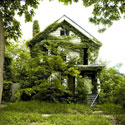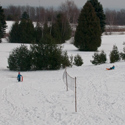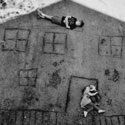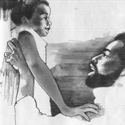We've run into old friends at Eastern Market and I'm telling a story. I forget my daughter is there.
Our neighborhood was once a true ghetto, first a neighborhood of Eastern-European Jews and then one of the only places in Detroit that black people were allowed to live. Through racist clauses common in land conveyances early in the twentieth century, blacks were not allowed to purchase or rent property in most of the city outside of what was then known as Paradise Valley and the Black Bottom. The influx of black workers from down south in the 1920s swelled the population in this neighborhood to the point where overcrowding was a major problem. Still, like the famous black neighborhoods in other cities, music and culture thrived here. Duke Ellington and Ella Fitzgerald performed regularly at the clubs in Paradise Valley. There were doctors and poets and petty criminals. The Nation of Islam was born here.
Eventually it became illegal to prevent the transfer of property to an entire race, and the neighborhood ebbed into a ramshackle slum as middle class blacks poured into other parts of the city. The old neighborhood was emptied and leveled in the 1950s for a highway and the redeveloped neighborhood designed by Mies van der Rohe where we chose to live. While digging in our garden I often find red bricks not a foot beneath the surface, all that remains of the bulldozed homes and businesses of the Black Bottom.
When we first moved here, I became enamored with the below-grade Grand Trunk Railway line that formed the eastern border of the old Black Bottom. When our neighborhood was built, they tore apart the urban fabric of streets for a series of parks and impassable cul-de-sacs. But when I started walking with the dog down in the old abandoned railway line, I got a real sense of the grid of the old neighborhood: old bridges remained over the sunken tracks that once connected streets which no longer exist. I found a nineteenth-century map of the city and spoke aloud the names of those streets: Champlain; Mullet; Sherman; Macomb. All that remained of those streets were buried bricks and bridges.
The railway line is called the Dequindre Cut, named (like most north-south streets in eastern Detroit) for the French settler whose narrow ribbon farm once stretched all the way to the river. When I first started exploring it, the cut was a wild place filled with overgrown invasive plant species, trash, and empty cans of spray paint left by the graffiti artists who'd turned an entire mile of the cut and the undersides of its bridges into the most spectacular urban canvas I have ever encountered. They called the bellies of these bridges "the caverns," and the underside of each was splashed with an ever-changing archaeology of color even the most stodgy crier of vandalism couldn't deny was art. The cut was home to a dozen homeless men, countless ring-necked pheasants, rabbits, raccoons, and even foxes. It was like a wilderness in the middle of the city, and I used to go down there several times a week.
One of those times (I tell my friends as Juniper listens from the crook of my arm) I was walking in the cut when I came across a naked man standing on a cement pylon. I made eye contact and nodded, and he nodded back. I wasn't scared and I didn't feel threatened by this naked man. It was fairly obvious he wasn't carrying any concealed weapons. It seemed a little cold to be standing on a cement pylon completely naked, but there he was.
"What was the naked man doing?" Juniper asks.
I keep telling the story, ignoring her repeated queries. After I'd walked the mile up to the market and started back, I became wary as I returned to the place where the naked homeless man had been. I need not have worried. There he was down ahead, still naked, playing a mournful song on a battered-looking trumpet.
I go on to describe how the cut has now been cleared of all its trash and brush, how the homeless men and pheasants and wild dogs have been driven out into the surrounding neighborhoods (twice now I've found a ring-necked pheasant on our doorstep). They are turning the cut into a paved biking/jogging trail, replanting native species, and connecting it to Detroit's spectacular new riverfront. For months the sound of heavy equipment knocking down those old Black Bottom bridges has started early each morning, the sound of the last traces of the old neighborhood churning into dust. Even in Detroit, where often there is no incentive to bury the past, history finds some way to disappear. It is bittersweet, I say, having loved what it was but also looking forward to what this new "safe" green space will mean for our neighborhood. Juniper tugs at my sleeve again:
"What did you say about a naked guy, Pops?"
And for two weeks I have been answering questions about the naked guy.
Every day, we go jogging and she asks me to tell her about the naked guy. I weave a story for her as she rolls through a green park that covers long-silent streets, a story not so different from the one above. I tell her about factories that once needed men and steel. I tell her about a neighborhood full of men and women and children who couldn't live anywhere else because other people were cruel and the laws unfair. I tell her how steel was brought on ships down the river and taken right past this neighborhood to the factories by steam locomotives. I tell her those factories closed and the trains were no longer needed, and then the tracks became overgrown and wild like a jungle full of plants and animals and a man came to live there and decided one day he no longer wanted to wear clothes while he played his trumpet. So he didn't, and in this jungle there was no one to tell him he had to.
My wife is not privy to these conversations.
She was having lunch with one of the kid's classmates and his mother at the market the other day, and they started talking about how nice it would be to have the paved cut connecting the market and the river. "Are you talking about the cut?" the kid asked my wife. Wood started explaining to her what the cut was. "No mama," she replied. "I know what the cut is. The cut is where the naked guy lives. The naked guy who plays his trumpet."
 Last April, Wood wrote a post about Juniper's beloved doll "Addie," a $2.99 bean-bag piece of crap from Target. Some wise commenter noted that we should buy more than one Addie, so we did. We should have bought dozens of them, and kept them like those Jengo Fett clones in the new Star Wars movies, marching around in Wood's closet, eating gruel at long miniature cafeteria tables, waiting for the day that each will be called into service. The Addies you see in the picture above are, from left to right, Addie #2 and Addie #4. Addie #1 was abandoned somewhere in the deep recesses of Golden Gate Park, and is now struggling to survive by collecting miniature recyclable cans in miniature garbage bags and fighting pigeons and rats for chunks of rice that old Chinese ladies toss out in giant buckets near Lloyd lake. Nobody knows what happened to Addie #3. We speculate Juniper finally succeeded in her mission to convince Addie #3 to ride a pigeon. Maybe Addie #3 simply saw her opportunity to hitch a ride on a mangy bird and get the fuck away from us one fateful day. It is still a mystery.
Last April, Wood wrote a post about Juniper's beloved doll "Addie," a $2.99 bean-bag piece of crap from Target. Some wise commenter noted that we should buy more than one Addie, so we did. We should have bought dozens of them, and kept them like those Jengo Fett clones in the new Star Wars movies, marching around in Wood's closet, eating gruel at long miniature cafeteria tables, waiting for the day that each will be called into service. The Addies you see in the picture above are, from left to right, Addie #2 and Addie #4. Addie #1 was abandoned somewhere in the deep recesses of Golden Gate Park, and is now struggling to survive by collecting miniature recyclable cans in miniature garbage bags and fighting pigeons and rats for chunks of rice that old Chinese ladies toss out in giant buckets near Lloyd lake. Nobody knows what happened to Addie #3. We speculate Juniper finally succeeded in her mission to convince Addie #3 to ride a pigeon. Maybe Addie #3 simply saw her opportunity to hitch a ride on a mangy bird and get the fuck away from us one fateful day. It is still a mystery.
Addie #2 is really approaching mandatory retirement age. You can tell because she's starting to look like something you'd find in a goth teenager's high school "found object" art project. Juniper has applied "makeup" (a black marker) to one eye and even after several trips through the washing machine, Addie's onesie is no longer white, but a distinctive shade of puke gray. Also, Addie #2 smells. She is covered in food and has been dropped in the pigeon-shit water at the park one too many times. I'm going to have to come up with a good way to retire her, maybe dress her like a Wagnerian soprano and float her out into Lloyd lake in a balsa wood boat and shoot miniature flaming arrows at it. See ya, Brunnhilde.
Don't worry, though, I'll march Addie #4 out from her hiding place before we have our Viking funeral for #2. The trauma will be minimal and totally outweighed by the awesomeness.
Pediatric psychoanalyst Donald Winnicott established the idea of "transitional objects" as tools to delineate one's physical body from the outside world and learn the relationship between self and other. In Winnicott's view, through the transitional object, a child safely moves from the symbiotic relationship with its mother to being more independent, retaining the feelings of security through the lingering trace of the caregiver even when alone. The infant and her future counterpart will return to the transitional object to sleep or in times of need. I think Addie #1 may have originally played the role of a transitional object to Juniper (she never grew attached to any blankets or stuffed animals), but beyond simply acting as transitional objects, Addie #2 and her recent colleagues have become full-on surrogates for Juniper's adventurous side. It's some serious voodoo shit. Anything that Juniper is too nervous to try, Addie #2 gets to do it first, such as swimming in the pool at Blogher, eating tofu scramble, going down the tall slide, trying the intimidating spinning apparati at the playground, breakdancing, funny-car racing, bungee jumping, and even going pee pee in the potty (accompanied by the psssssssss sound I taught her over the last two days, much to Wood's embarassment).
The other fascinating aspect of the new Addie is Juniper's imitative maternal care for her. Like her colleague William Grosspietsch, she nurses Addie at her own "booboobs," and she loves feeding Addie"num nums" while in her high chair. Addie gets taken for strolls around the block, sits in adjoining swings at the playground, and gets to "ride" on the backs of real dogs tied outside the coffee shop like the baby in her favorite books. Juniper will even put her in a shoebox coffin, cover her with a tissue, and order us to "shhhhhh!" if we say anything during or after the process. Juniper is either practicing to be a funeral director, or she is putting Addie to "bed." She will even rock Addie to sleep the same way we rock her, and the other day she began singing her first song: "ockaby, baby, eee oh eee opps." It's so fucking cute I want to shoot myself.
All of that love and attention aside, Juniper is not above treating Addie with recklessness that deserves intervention from DPS (Doll Protective Services), enough to land Addie #2 in doll foster care. When looking at Juniper's face in the set of pictures that follow, I can't help thinking that's the same face Aztec priests must have made while stomping on the hearts of their victims in the ecstacy of a child sacrifice. If Juniper is learning to care for her doll from the care we are providing her, where the hell did she learn to do this: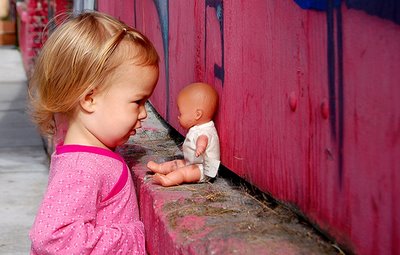




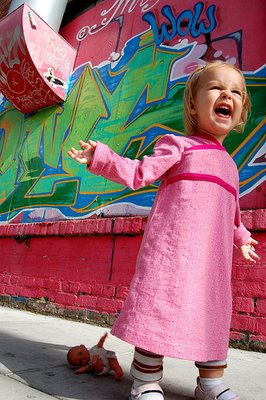
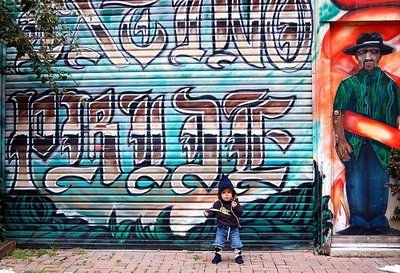 A reader recently posed the following question via e-mail, which I will answer in the traditional "ask the judgmental hipster asshole" fashion:
A reader recently posed the following question via e-mail, which I will answer in the traditional "ask the judgmental hipster asshole" fashion:
Q. Dutch, why the fuck do you always take pictures of Juniper in front of graffiti?
A. I lived in Pittsburgh for a month or so when I was studying for the bar exam and when I was drunk one sweltering afternoon I saw this Cable Access documentary on the Pittsburgh graffiti scene. There's this guy named Mook who leaves his tag in ridiculously precarious spots on top of bridge towers. The documentary was interesting and made me look at graffiti in a whole new light. Also, Wood's dad is a probation officer who knows the guy in charge of the city's effort to clean up all the graffiti. His stories of taking on the graffiti artists made HBO's The Wire look like the Keystone Kops. There was this cool bike trail along a Pittsburgh highway wall that was covered in graffiti. I really started to respect the talent of the people who were doing it, in a gay 1978 Manhattan art gallery kind of way, I guess.
When I first moved to San Francisco, I noticed the city has this thriving poser hip hop DJ culture that just cracked my shit up, and, as their books on early eighties hip hop that they buy at Giant Robot tell them, graffiti is as important to hip hop culture as "bustin' rhymes over beats." Don't get me wrong, I went through it, too. But that was high school. These people were in their thirties.
Any feelings of appreciation I had for street art felt like cliche, so I buried them. One time Wood, Juniper and I were riding the N-Judah through the tunnel under Buena Vista Park and four dudes in baggy clothing walked up and down the train with big permanent markers tagging the windows and empty seats. Everyone on the half-full train just ignored them. Wood and I couldn't help but laugh at the lameness of it. San Francisco is like hip hop Disneyland: it's got the gritty urban architecture, a population of bored white youth listening to underground hip hop, and yet it's perfectly fucking safe, even for sidewalk babies. There are commissioned graffiti murals on buildings that have $2 million condos inside. Graffiti is constantly being incorporated into ad campaigns and corporate billboards to lend street authenticity to the products advertised. I thought, what could be the ultimate emasculation of San Francisco graffiti as hip hop posturing? Why, taking pictures of a weak ass little baby in front of it, of course!
Bottom line: I thought these shots were funny.
But as time went on and I kept doing it, I realized I was really starting to appreciate again this "vandalism" that brings color and ad-less flavor to the advertising permeated streets. Besides, no one wants to see the pile of toys or the half-empty laundry hamper cluttering your living room in pictures of your kids. The vibrant colors and loopy, indecipherable letters of graffiti made perfect backgrounds. So I co-opted the art for my own purposes, you could say, just like the corporations I hated. But I loved that even the street artists who could make good money doing it legitimately still crept out at night and broke the law and created art for its own sake, leaving "letters from God dropt in the street, and every one sign'd by God's name"; art free for anyone to appreciate or scorn. Like blogging, I guess, only more beautiful. Through the photographs I was able to borrow from the transient beauty of this art, to make a visual record of this part of Juniper's life living here, in a city filled with color where people come and people go just like the words and spraypaint on the walls, which get replaced as soon as they are washed away.
I've got a whole flickr set of these "Graffiti Girl" pictures, and I've started a flickr group for you to upload shots of your babies in front of graffiti in your own towns, if you are so inclined.
Oh, and if anyone else wants to ask us any big questions, we'd be happy to do further Q&As. Ask in the comments or by e-mail.



